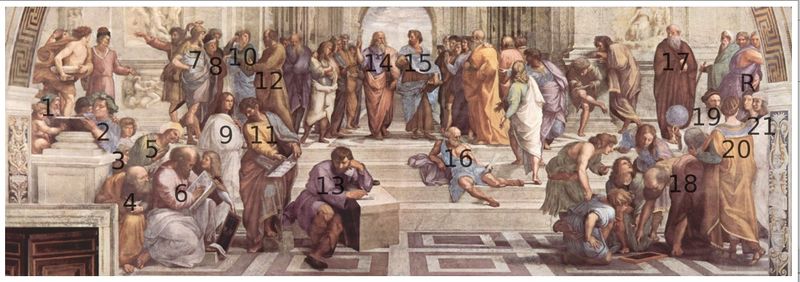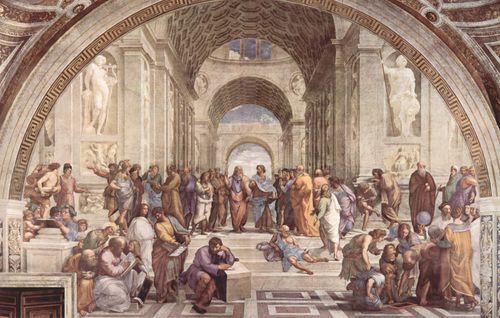The School of Athens
From Artist
Revision as of 20:07, 8 April 2010 by imported>Jacques Ducloy (→The topic)
The School of Athens, or Scuola di Atene in Italian, is one of the most famous paintings by the Italian Renaissance artist Raphael.
The painting
The School of Athens was painted between 1510 and 1511 as a part of Raphael's commission to decorate with frescoes the rooms now known as the Stanze di Raffaello, in the Apostolic Palace in the Vatican. [1]
The topic

The bracketed names are the contemporary characters from whom Raphael is thought to have drawn his likenesses.
1: Zeno of Citium 2: Epicurus 3: Federico II of Mantua? 4: Anicius Manlius Severinus Boethius or Anaximander or Empedocles? 5: Averroes 6: Pythagoras 7: Alcibiades or Alexander the Great? 8: Antisthenes or Xenophon? 9: Hypatia (Francesco Maria della Rovere)[2] 10: Aeschines or Xenophon? 11: Parmenides?
1: Zeno of Citium 2: Epicurus 3: Federico II of Mantua? 4: Anicius Manlius Severinus Boethius or Anaximander or Empedocles? 5: Averroes 6: Pythagoras 7: Alcibiades or Alexander the Great? 8: Antisthenes or Xenophon? 9: Hypatia (Francesco Maria della Rovere)[2] 10: Aeschines or Xenophon? 11: Parmenides?
See also
Interwiki links
- The School of Athens on Wikipedia.
References
- ↑ most information of this page come from:
The School of Athens. (2010, April 4). In Wikipedia, The Free Encyclopedia. Retrieved 18:59, April 8, 2010, from http://en.wikipedia.org/w/index.php?title=The_School_of_Athens&oldid=353846611 - ↑ According to Rudy d'Alembert (see Rudi Mathematici Template:It, Unwin & Carline, 2009) Raphael portrayed Hypatia giving her the face of the fifteen years old Francesco Maria della Rovere, to hide her true identity.
